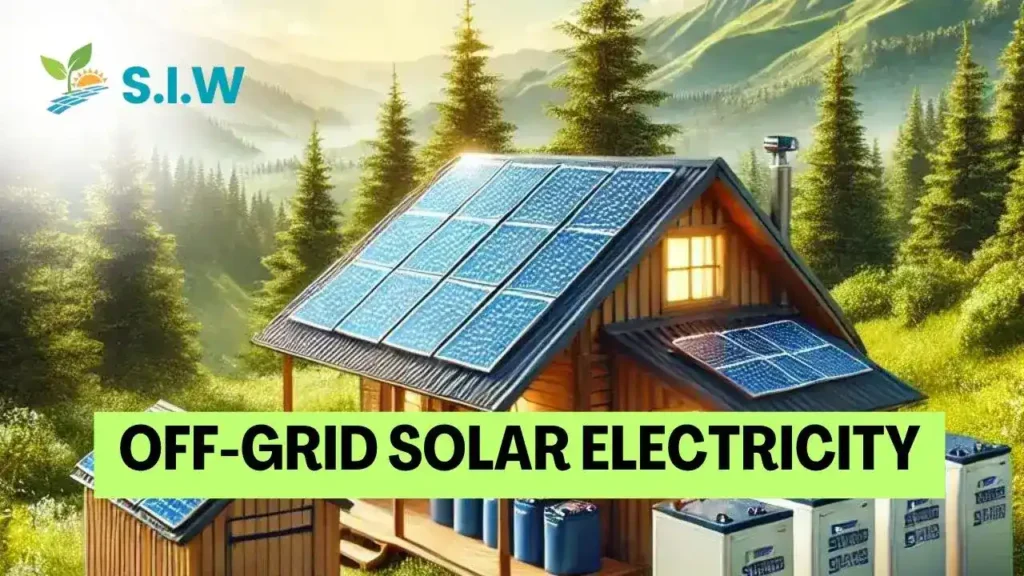In an era where sustainability and energy independence are paramount, off-grid solar electricity provides a powerful solution. This guide will cover everything from how off-grid solar systems work, their benefits, key components, the installation process, and whether this option is right for you. Let’s explore how off-grid solar can help you achieve self-sufficiency and reduce your environmental impact.
What is Off-Grid Solar Electricity?
Off-grid solar electricity refers to a power system that operates independently from the traditional utility grid. Solar panels in these systems generate electricity from sunlight, and any excess energy is stored in batteries for later use when sunlight is unavailable. This offers complete energy independence, making it a suitable option for remote locations or for those seeking a self-sustained energy solution.
With growing concerns over electricity costs and the need for cleaner energy, more homeowners and businesses are considering off-grid solar power as a viable alternative.
Benefits of Off-Grid Solar Systems
Off-grid solar power systems offer a range of benefits that make them a preferred choice for many:
Energy Independence
By being disconnected from the utility grid, off-grid systems allow you to avoid power outages and fluctuations in energy prices. You produce and store your own electricity, eliminating dependency on external sources.
Sustainability
Solar energy is a renewable resource, which means using it reduces the reliance on fossil fuels. By going off-grid, you’re contributing to the reduction of carbon emissions, making your energy consumption more environmentally friendly.
Remote Power Access
For homes or businesses in rural or remote locations, accessing grid electricity can be costly or even impossible. Off-grid solar systems are an ideal solution for providing reliable power in areas where traditional utilities aren’t feasible.
Long-Term Savings
While the initial investment in an off-grid solar system can be substantial, the long-term savings can be significant. Once the system is set up, the absence of monthly utility bills and the possibility of receiving tax incentives or rebates can lead to substantial financial savings over time.
Customization
Off-grid solar systems can be customized to meet your specific energy needs. Whether you’re powering a small cabin or a large property, these systems can be scaled accordingly.
Key Components of an Off-Grid Solar System
Understanding the components of an off-grid solar system is essential to building a setup that meets your energy requirements.
Solar Panels
Solar panels are the most visible part of any solar energy system. They capture sunlight and convert it into electricity. The number of panels needed depends on the amount of energy you plan to produce.
Battery Storage
One of the main features that sets off-grid systems apart from grid-tied systems is the need for battery storage. Batteries store excess energy produced during sunny days for use at night or during periods of low sunlight.
Inverter
The inverter converts the direct current (DC) electricity generated by the solar panels into alternating current (AC) electricity, which is used to power most household appliances.
Charge Controller
A charge controller regulates the flow of electricity between the commercial solar panels, batteries, and inverter, preventing the batteries from overcharging and ensuring efficient energy use.
How Does an Off-Grid Solar System Work?
Off-grid solar systems generate electricity from sunlight through solar panels. During daylight hours, solar panels produce energy, which is either used immediately or stored in batteries. The batteries store excess energy to ensure power is available during non-sunny periods, such as night or cloudy days. The inverter converts the stored energy into usable AC power for household appliances.
Steps to Install an Off-Grid Solar System
Setting up an off-grid solar system involves several key steps:
- Assess Energy Needs: Start by determining how much electricity your household or business uses. This helps in deciding the size of the system you’ll need.
- Choose Components: Select the solar panels, batteries, inverter, and charge controller that suit your energy requirements.
- Find the Right Location: Ensure the solar panels are installed in an area that receives ample sunlight throughout the day.
- Install and Connect: Once the components are chosen, installation should be handled by a professional to ensure everything is properly connected and functional.
- Monitor and Maintain: Regularly check the system for any issues and perform maintenance, such as cleaning the panels and checking battery levels.
Is Off-Grid Solar Right for You?
While off-grid solar systems provide energy independence and sustainability, they may not be suitable for everyone. Consider factors such as your location, energy needs, and budget. If you live in a remote area with limited grid access or are committed to reducing your reliance on fossil fuels, an off-grid solar system could be a perfect solution.
However, the initial investment can be high, and you must be prepared to handle system maintenance and occasional battery replacement. Assess your long-term goals, and consult with professionals to determine the best fit for your needs.
Off-Grid Solar System Maintenance and Costs
Maintenance for off-grid solar systems is generally minimal but essential for long-term efficiency. Solar panels should be cleaned periodically to ensure they receive maximum sunlight. Battery maintenance is crucial, as they typically need to be replaced every 5-15 years, depending on the type and usage. Inverters and charge controllers may also need occasional servicing.
In terms of costs, an off-grid solar system can range from $10,000 to $30,000 or more, depending on the size and components. While the initial setup is expensive, the absence of utility bills, coupled with potential government incentives, makes off-grid solar a worthwhile investment over time.
Conclusion
Off-grid solar electricity is a promising solution for those seeking energy independence, sustainability, and long-term cost savings. With the right setup, you can enjoy uninterrupted power and contribute to a greener planet. Whether you’re living in a remote area or simply want to reduce your reliance on traditional power grids, an off-grid solar system can provide a reliable and eco-friendly energy source for years to come.








